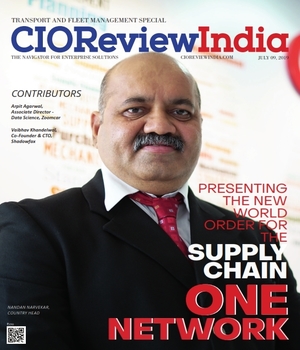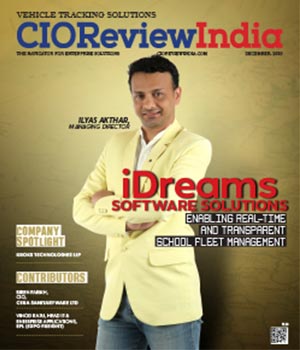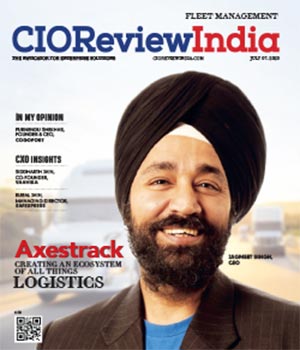
Adoption Of New Technology Trends In The Forwarding Industry
Vinod Raju, Head IT & Enterprise Applications, EFL (Expo Freight) | Wednesday, 04 December 2019, 04:42 IST
 As Technologies such as Cloud Computing, IOT, RPA etc, start maturing, its adoption too, within the “price conscious” forwarding industry has been increasing.
As Technologies such as Cloud Computing, IOT, RPA etc, start maturing, its adoption too, within the “price conscious” forwarding industry has been increasing.
Cloud Computing has been a blessing for the industry, until a few years ago, software applications on the cloud were seen with a lot of suspicion mainly for security reasons. Senior Management of midsized Companies refused to even entertain the thought of housing their proprietary data on equipment outside their premises.
Over time there was a small paradigm shift, where companies accepted the concept of their own servers, with the propriety data, collocated in external Data Centres. This resulted in a small drop in IT Infra costs, incurred on maintaining “in-house” Data Centres (Server Rooms).
With the maturing of the Cloud Computing & Host Technology services, many concerns such as security were addressed. The advantages, especially the economics of it, were too compelling for companies to overlook this technology trend, resulting in widespread adoption.
Some advantages.
Economic Advantages.
1. Reduction in Infrastructure Costs.
In the cloud environment, Capital Expenditure is virtually non-existent. You don’t need to buy your own equipment as all resources required are on the cloud given by the service provider. And you only pay for what you use. The only infra required is the network infrastructure for connecting securely to the cloud.
2. New Breed of Software Solutions The new breed of software solutions adapted beautifully to the new environment and took full advantage of the “pay for what you use” concept.
Not only the Forwarding ERP solutions, but all software solutions such as HR solution, Office Automations Solutions etc, generally used by companies, offer the SAAS model, and this has now become very popular and soon (if no already) will become a norm in the industry.
In this model, the software provider hosts the solution on the cloud. Subscriptions are charged either based on number of users or number of transactions or a combination of the two. This becomes a very economical solution for the Forwarder as they save costs on
• Setting up servers for implementing the ERP solution.
• Procuring database licenses for the ERP.
• Hiring personnel to maintain the systems – Thereby maintaining a leaner IT Workforce.
Software Standardisation
With the clear cost advantages associated with SAAS, companies now prefer to “compromise” on customised software solutions (either built in-house or exclusively for them) and go with standard solutions offered by vendors in the SAAS model. This has resulted in more open standard software systems which have the capability to exchange information between software applications very easily. By using standardised software, processes in the forwarding industry have also standardised. This has the potential to bring about great process efficiencies as the standard software solutions adopt best practices in the industry thereby bringing increased productivity in companies that use the standard solution.
Visibility
The SAAS module has unwittingly resulted in a very essential service requirement that can never be satisfactorily fulfilled by forwarders / logistics providers earlier but can confidently be given now is “visibility”.
An essential service requirement of any logistics service provider to its customer is the ability for the customer to know the whereabouts of their shipments in real-time at any given point of time.
With standardised software solutions hosted on the cloud and with these standard solutions having the capability to push & pull data from other software systems (including systems of Airlines & Shipping lines), it is now possible for a customer to know the status of their shipments through Track & Trace Solutions, which is a great benefit to the customer.
IOT
Another trend which is fast being adopted within the forwarding industry is the Internet of Things. The most common use of this is the RF ID.
Attach the RFID tag to a container, box, pallet etc , which can transmit basic information via a local reader and populate the information received into a software solution hosted on the cloud, which is also in their mobile apps and customers can see the status of their shipments at any time & anywhere.
With Smart Sensors it is possible to check status of temperature sensitive shipments.
Humidity of perishable goods can virtually be tracked online. If the temperature or humidity of the container transporting perishables increases / decreases and if this information is available to the transporter, corrective action can be taken immediately thereby reducing the quantum of wastage during transportation.
IOT has brought great visibility and transparency in for the Customers & the Services Providers alike, especially in the Road Transportation business. Due to online tracking and visibility, pilferage too is reduced.
Customers or 3PL Services Provides can plan their inventories and stock in a more accurate manner knowing the almost ‘exact time’ when shipments will be received at warehouses, bringing about major efficiencies in warehouses.
Data Analytics
The potential of Data Analytics too using BI tools, is now beginning to be appreciated by the Forwarding Fraternity.
With capabilities of BI tools analysing large amounts of structured data (data in rows & columns) as well as unstructured data ( data such as emails, word documents, photos etc), Companies have begun to leverage this major “unused” Asset…. ‘data’.
With AI capabilities in the BI tools, forwarders can now (using historical data)
• Conduct focused Sales Campaigns, based of Customer seasonality.
• Approach the appropriate Carriers to use for appropriate Trade Lanes.
• Identify which Forwarding Service to provide Customers at what point of the year.
• Identify potentially highly profitable customers, who otherwise may not be very apparent based on the standard conventional reports generated.
In Road Transportation, route planning can be very effectively done using Data Analytics & AI. This can bring about greater line haul efficiencies and cost reductions, thereby improving the overall profitability of a service.
There are many more areas where Data Analytics can be used within an organization to improve process efficiencies and ultimately profitability and growth of a company.
An emerging technology that has great potential to bring about process efficiencies is a combination of Robotic Process Automation (RPA) & AI. This is explained a little more in detail below.
The biggest advantage of modern day popular BI & Data Analytics tools are:
• Its ease of use. It does not require high levels of Information Technology expertise to use these tools.
• And its capability to process high volumes of data and generating results very quickly. Making BI & Data Analytics a much favoured technology among Senior Managements.
RPA with AI
Robotic Process Automation can be used in processes which are repetitive, and which do not have too many variations. Eg. entering data into software systems. Documents received from Customers, Vendors etc, which need to be updated into xls files or software systems can be scanned. BOTs with the capability to read the scanned documents and interpret its contents using AI and its self-learning capabilities (NLP), can convert the information into structured data as per the software systems requirement. The more the transactions that pass through this process the more efficient and accurate does the process become due to its AI & NLP capabilities.
RPA has the potential reduce manual data entry effort to a very great extent. This can result in great processing efficiencies and reduction in costs with a reduction in manpower involved in the data entry effort.
Seeing its potential in bringing about efficiencies many forwarding companies have begun conducting Pilot projects to check its adaptability in live scenarios.
This technology trend can be a huge game changer in bringing about internal process efficiencies within an organization.
With all the various Technologies mentioned above, if implemented correctly and the appropriate areas, Logistics Companies have a great opportunity to become lean, process efficient and will have the ability to increase growth with minimal effort.
CIO Viewpoint
Adoption Of New Technology Trends In The...
By Vinod Raju, Head IT & Enterprise Applications, EFL (Expo Freight)
Vehicle Tracking Bringing Transparency In...
By Biren Parikh, CIO, CERA Sanitaryware Ltd
B2B Integration Key to Supply Chain Excellence
By Dan Sellers, CIO, WSI
CXO Insights
Kroks Technologies LLP Delivering Tracking,...
By Ashith Kunder and Ashwin Kunder, Co-Founders
Technology Pushing Cost Savings in Logistics
By E.R. Williams, Co-Founder & Technology Lead, Zipline Logistics
Technology: Building a Competitive Advantage in...








